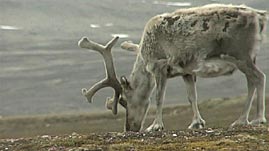Teachers' Domain - Digital Media for the Classroom and Professional Development
User: Preview

Source: LOKE Films and AMAP 2002 Assessment



This video segment adapted from LOKE Films and the Arctic Monitoring and Assessment Programme describes how contaminants such as mercury and PCBs affect Arctic wildlife. Learn about how pollutants accumulate in the fats of animals and how species at the top of a food chain, such as glaucous gulls and polar bears, have higher levels of toxins than species at lower trophic levels.
Human economic activities, such as manufacturing, energy generation, and farming, release pollutants into the environment that can contaminate ecosystems far from their point of origin. Heavy metals and persistent organic pollutants (POPs)—chemicals that break down slowly and persist in the environment—are of particular concern. These pollutants resist degradation and can build up to toxic levels within organisms. Polychlorinated biphenyls (PCBs) are such pollutants; they are chemicals used in a variety of industrial processes. While generally released in the low- or mid-latitudes, PCBs are carried by global winds and ocean currents to locations as far away as the Arctic, where they are trapped and build up in the ecosystem. Arctic organisms exposed to chemicals in the air or in the water absorb the pollutants; the toxins then move up the food chain from prey to predator.
Scientists describe the position of an organism in an ecosystem's food chain as a trophic level. Near the bottom of the food chain, or at a low trophic level, organisms such as plankton and marine invertebrates have relatively low levels of toxins. However, due to a process known as biomagnification, organisms at higher trophic levels have higher concentrations of toxins. This occurs because toxins accumulate in the fatty tissues of organisms, becoming concentrated, and then higher trophic level organisms feed on tainted lower level organisms and acquire all their toxins. For example, seabirds eat fish; when they eat the fish they capture the energy from the fish as well as all the toxins stored in the fish. Because the seabirds eat large quantities of fish, they end up ingesting a lot of toxins. In addition, because the toxins are not easily excreted, they accumulate further in the seabirds. Studies have shown that concentrations of POPs can be biomagnified by 10 to 1,000 times in seabirds.
Thus, animals at different trophic levels will have varying levels of contaminants. For example, baleen whales, which feed on plankton, krill, and small fish, are relatively low in the food chain and have fairly low levels of contaminants. However, toothed whales, which consume fish, squid, and marine mammals, are higher in the food chain and have correspondingly higher levels of contaminants. Similarly, seabirds such as glaucous gulls, which prey on other seabirds and scavenge marine mammal carcasses, have higher concentrations of toxins compared to seabirds that eat only fish. Polar bears, at the top of the Arctic food chain, primarily eat seals—including their nutrient- and contaminant-rich blubber—and have the highest levels of PCBs of all Arctic species.
 Loading Standards
Loading Standards Teachers' Domain is proud to be a Pathways portal to the National Science Digital Library.
Teachers' Domain is proud to be a Pathways portal to the National Science Digital Library.
